Timeline of Sussex History
This is a timeline of Sussex history. To read about the background to these events, see History of Sussex. See also the list of monarchs of Sussex.
This is a dynamic list and may never be able to satisfy particular standards for completeness. You can help by
expanding it with reliably sourced entries.
1st century
| Year | Date | Event | Reference |
|---|
| 43 | | Romans land on Sussex coast as part of the Roman conquest of Britain; kingdom created for Cogidubnus that includes much of what is to become Sussex. |
[1] |
| c.80 | | Kingdom of Regnenses or Regni, becomes a Roman civitas with its capital at what is now Chichester. |
[1] |
2nd century
| Year | Date | Event | Reference |
|---|
| c.150 | | Ptolemy's Geography mentions several places in what we to become Sussex including Magnus Portus, Noeomagus (Noviomagus Reginorum), Novus Portus and the Flavius Trisantona (River Arun). |
[2] |
3rd century

Roman masonry in the walls of Anderitum
5th century
6th century
7th century
8th century
9th century

Tombstone of Æthelwulf of Wessex, buried in 858 at Steyning
| Year | Date | Event | Reference |
|---|
| c.827 | | Sussex annexed by Kingdom of Wessex | [22] |
| 828 | | Historia Brittonum is written, which refers to the "Night of the Long Knives" in which Sussex is ceded by sub-Roman authorities to Saxons. |
|
| 839 | | Æthelstan becomes "King of the Dwellers in Kent, of the East Saxons, of the South Saxons and of Surrey" on the authority of his father, Æthelwulf of Wessex. |
[23] |
| 858 | | Æthelwulf of Wessex buried at Steyning. |
[24] |
| 860 | | Æthelberht of Wessex becomes king of Wessex. Sussex, together with Essex, Kent and Surrey, is fully subsumed as part of this kingdom. |
[25][26] |
| 885 | | King Alfred meets his biographer, Asser, for the first time at Alfred's royal estate at Dean in Sussex. |
[27] |
10th century
11th century
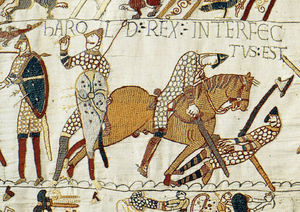
Scene from the
Bayeux Tapestry depicting the death of King Harold at the Battle of Hastings
12th century

The coat of arms of
Hastings, shows a motif that features widely in the heraldry of the
Cinque Ports 13th century

A medieval wall painting of St Richard of Chichester
14th century
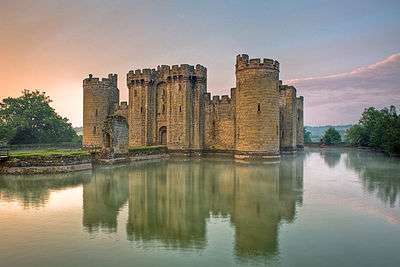
Bodiam Castle was constructed in 1385
15th century
16th century
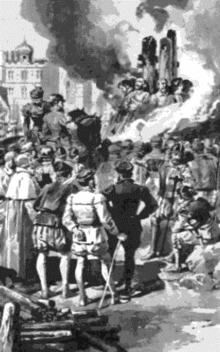
Depiction of martyrdom of Richard Woodman and nine others who were burned in Lewes
17th century
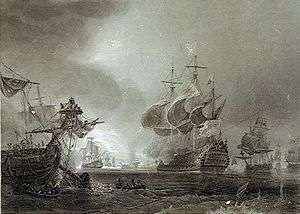
Steel engraving of scene from Battle of Beachy Head
18th century

Henry Pelham, who became the British Prime Minister in 1743
19th century
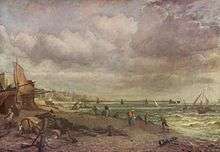
Brighton's Chain Pier, Sussex's earliest pier, was built in 1823. Painting by
John Constable c.1824
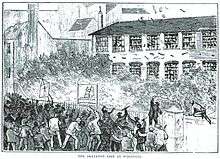
The Skeleton Army rioting in Worthing in 1884
| Year | Date | Event | Reference |
|---|
| 1801 | 27 November | Prince Augustus Frederick becomes Duke of Sussex | [87] |
| 1804 | 3 June | Birth of Richard Cobden, statesman and co-founder of the Anti-Corn Law League | [88][89] |
| 1804 | | Charles Lennox, 4th Duke of Richmond, gets royal permission for the title 'Sussex' to be transferred from the 25th Regiment of Foot to the 35th (Royal Sussex) Regiment of Foot. This regiment was replaced by the Royal Sussex Regiment 180 years later in 1881. |
[90] |
| 1813 | | Ashburnham blast furnace is closed, the last in the Weald as iron production is produced more cheaply in the Midlands and the north of England using coke. |
[91] |
| 1822 | | Gideon Mantell discovers dinosaur teeth in Tilgate Forest that he later names as a new genus of dinosaur found 'iguanadon', the second named genus of dinosaur. |
|
| 1823 | | Sussex's first pier, the Chain Pier, is built in Brighton. |
[92] |
| 1828 | 11 June | Sussex County Hospital (now Royal Sussex County Hospital) opens in Brighton |
[93] |
| 1830 | | Captain Swing riots take place across Sussex and England. |
[94] |
| 1832 | | The Petworth Emigration Scheme is set up by the Earl of Egremont. Over the next five years around 1,800 working class people from Sussex and neighbouring counties emigrate to Upper Canada to escape poverty. |
[95] |
| 1836 | 27 December | Lewes avalanche kills 8 people. |
[96] |
| 1837 | 27 March | Death of Maria Fitzherbert, longtime companion of the future King George IV of the United Kingdom at her home in Steine House, Brighton. |
[97] |
| 1839 | 1 March | Sussex County Cricket Club formed, the first county cricket club. |
[98] |
| 1840 | 11 May | The first railway line in Sussex, from Brighton to Shoreham opens. |
[99] |
| 1853 | | Lewes Prison, the local prison for male prisoners in Sussex, is opened. |
[100] |
| 1861 | 25 August | Clayton Tunnel rail crash results in 23 deaths. |
|
| 1865 | | The County of Sussex Act 1865 confirms the sub-division of Sussex into east and west areas for purposes of administration. |
[101] |
| 1884 | | Skeleton Army riots in Worthing |
[102] |
| 1889 | | County Councils were established for Sussex's eastern and western divisions. |
|
| 1893 | | An outbreak of typhoid fever in Worthing results in 188 fatalities. |
[103] |
| 1896 | | The National Trust acquires its first property, Alfriston Clergy House in Alfriston. |
[104] |
20th century
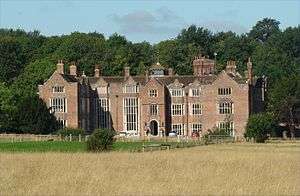
Danny House in Hurstpierpoint, where the terms of the armistice to be offered to Germany were agreed in 1918
21st century

The South Downs was designated a national park on 1 April 2010
References
- 1 2 Cannon 2009, p. 541
- ↑ "The Geography of Ptolemy". Roman Britain Organisation. Retrieved 14 May 2015.
- ↑ "Anderitum". Pastscape, Historic England. Retrieved 14 May 2015.
- ↑ Grehan & Mace 2012, p. 8
- ↑ Sally White. The Patching hoard published in Medieval Archaeology. pp. 88-93
- ↑ ASC Parker MS. 477AD."Her cuom Ęlle on Bretenlond 7 his .iii. suna, Cymen 7 Wlencing 7 Cissa, mid .iii. scipum on þa stowe þe is nemned Cymenesora, 7 þær ofslogon monige Wealas 7 sume on fleame bedrifon on þone wudu þe is genemned Andredesleage."
- ↑ Grehan & Mace 2012, p. 9
- ↑ ASC Parker MS. 485AD.
- ↑ ASC Parker MS. 491AD.
- ↑ Grehan & Mace 2012, p. 10
- ↑ ASC Parker MS. AD607.
- ↑ Keys, Jim (2010). The Dark Ages. Lulu.com. p. 97. ISBN 9781445229850.
- ↑ Creighton 2014, p. 25
- 1 2 Bede.HE.IV.13
- ↑ Bede.HE.IV.15
- ↑ Kirby 2000, p. 114
- ↑ "Beyond the Tribal Hidage" (PDF) (PDF). University College London. Retrieved 14 May 2015.
- ↑ Fitzpatrick-Matthews, Keith. "Ravenna Cosmography -Group 6a: southern Hampshire/western Sussex". Retrieved 14 May 2015.
- ↑ Cannon, Cannon & Hargreaves 2009, p. 24
- ↑ Brandon 2006, p. 71
- ↑ Grehan & Mace 2012, p. 11
- ↑ Edwards, Heather (2004). "Ecgberht [Egbert] (d. 839), king of the West Saxons in the Oxford Dictionary of National Biography". Oxford University Press. Retrieved 22 June 2014.
- ↑ Points 2013, p. 29
- ↑ "Early Medieval – AD 410-1066" (PDF) (PDF). Chichester Harbour Conservancy. Retrieved 4 July 2014.
- ↑ Higham & Ryan 2013, p. 245
- ↑ Kirby 2000, p. 169
- ↑ Lapidge et al. 2013
- ↑ Lowerson 1980, p. 43
- ↑ Roach 2013, pp. 60–61
- ↑ Keynes 2013, p. 36
- ↑ Mason & Brink Shoemaker 2004, p. 20
- ↑ Logan 2013, p. 159
- ↑ Armstrong 1971, p. 44
- ↑ Armstrong 1971, p. 45
- ↑ Jones 2010, p. 18
- ↑ Jones 2010, p. 19
- 1 2 "Chichester Cathedral - its history and its art.". Chichester Cathedral. Retrieved 10 May 2015.
- ↑ "1088 Rebellion Against William II". www.sussexcastles.com. Retrieved 3 April 2015.
- ↑ Daniell 2013, p. 38
- ↑ Stanton 2015, p. 233
- ↑ Bartlett 1841, p. 258
- 1 2 Naylor 2013
- 1 2 Melton 2014, p. 782
- 1 2 3 Greahn & Mace 2012, p. 38
- ↑ Symonds, Richard. "Knepp Castle Timeline" (PDF) (PDF). Knepp Castle Estate. Retrieved 3 May 2015.
- 1 2 Greahn & Mace 2012, p. 69
- ↑ Hernon 2013
- ↑ "Victoria County History - The rape of Chichester". British History Online. Retrieved 9 Feb 2012.
- ↑ Seward 1996
- ↑ Campbell 1992, p. 193
- ↑ Jordan 1997, p. 118
- 1 2 "Constituencies - Chichester". The History of Parliament. Retrieved 14 April 2015.
- ↑ Longmate 2011
- ↑ Broadberry, Stephen; Campbell, Bruce M.S.; van Leeuwen, Bas (27 May 2010). "English Medieval Population: Reconciling Time Series and Cross Sectional Evidence" (PDF) (PDF). University of Warwick. p. 9. Retrieved 25 April 2015.
- ↑ Wagner 2006, p. 310
- ↑ Elwes & Robinson 1876, p. vi
- ↑ "Sussex EUS – Lewes" (PDF) (PDF). Lewes District Council. Retrieved 21 April 2015.
- ↑ "1381 The Peasants Revolt". Sussex Castles. Retrieved 21 April 2015.
- ↑ Cooper 2006, p. 80
- ↑ "Bodiam Castle". National Trust. Retrieved 16 April 2015.
- ↑ Potter 2012, pp. 116–117
- ↑ Fritze & Robison 2002, pp. 288–289
- 1 2 3 "Jack Cade's Rebellion/The Merfold Rebellion". Socialism or Your Money Back. Retrieved 16 April 2015.
- ↑ Spence 1999, p. 233
- ↑ Herrup 1989, p. 23
- ↑ Lehmberg 2014, p. 71
- ↑ "Battle of the Solent, 18th July 1545 - 19th July 1545". Threedecks.org. Retrieved 16 April 2015.
- ↑ "Remember remember...The Lewes 17". BBC. Retrieved 16 April 2015.
- ↑ Proceedings of the Huguenot Society of Great Britain and Ireland, Volume 28, Issue 5)
- ↑ Venn 2011, p. 420
- ↑ Challoner 1839, p. 143
- ↑ Taneja 2009, p. 71
- ↑ Shephard 2014, p. 328
- ↑ McCann 2004, p. xxxi
- ↑ "Sussex Flag". British County Flags. Retrieved 12 April 2015.
- ↑ McCann 2004, pp. xxxiii–xxxiv
- ↑ Manton 2013
- ↑ "The City of Chichester: Historical introduction". British History Online. 1935. Retrieved 1 April 2015.
- ↑ "Civil War Breaks Out at Arundel Castle" (PDF) (PDF). Arundel Castle. Retrieved 1 April 2015.
- ↑ "Ifield: Protestant nonconformity". British History Online: Victoria County History - Sussex A History of the County of Sussex: Volume 6 Part 3, Bramber Rape (North-Eastern Part) Including Crawley New Town... Ifield: Protestant nonconformity. Retrieved 30 March 2015.
- ↑ "Battle of Beachy Head 1690". Pastscape, Historic England. Retrieved 30 March 2015.
- ↑ "Past Prime Ministers - Henry Pelham". Gov.uk. Retrieved 21 March 2015.
- ↑ "David Arnold - 'Wilkes and Liberty' cried the crowds". Sussex Express. 2 November 2014. Retrieved 16 February 2015.
- ↑ Harper 2014, p. 30
- ↑ Begler 2007, p. 67
- ↑ Murland & Murland 2008, p. 60
- ↑ Knowles, Rachel (6 April 2013). "Prince Augustus, Duke of Sussex (1773-1843)". Regency History. Retrieved 21 March 2015.
- ↑ "Manuscripts and Special Collections - Richard Cobden (1804-1865; manufacturer and politician)". University of Nottingham. Retrieved 21 March 2015.
- ↑ Bloy, Dr Marjorie. "Biography = Richard Cobden (1804-1865)". Retrieved 21 March 2015.
- ↑ "35th (Royal Sussex) Regiment of Foot". National Army Museum. Retrieved 21 March 2015.
- ↑ Hodgkinson, Jeremy. "Iron - a Once Great Wealden Industry" (PDF) (PDF). Woodland Trust. Retrieved 21 March 2015.
- ↑ Drewry 1832, pp. 69–74
- ↑ "History of Royal Sussex County Hospital Programme Board Presentation" (PDF). Brighton and Sussex University Hospitals NHS Trust. Retrieved 19 March 2015.
- ↑ Fraser & Brown 2014, pp. 220
- ↑ Messamore 2004, pp. 91–100
- ↑ Locke 2011, p. 146
- ↑ Knowles, Rachel (16 October 2011). "Mrs Fitzherbert (1756-1837)". Regency History. Retrieved 18 March 2015.
- ↑ Scott 2011
- ↑ Christopher 2014
- ↑ D'Enno 2007, p. 157
- ↑ Leslie & Short 1999, p. 126
- ↑ Bennett 2003, p. 185
- ↑ Bristow 2003, p. 152
- ↑ Quinn 2007, p. 139
- ↑ "Sussex By The Sea Lyrics". Sussex History. Retrieved 18 March 2015.
- ↑ "Richebourg - The Day Sussex Died". The Royal Sussex Living History Group. Retrieved 21 February 2015.
- ↑ "Danny House - History". Danny House. Retrieved 17 March 2015.
- ↑ "Operation Sealion". History Learning Site. Retrieved 17 March 2015.
- ↑ Locke 2011, p. 154
- ↑ Barbier 2007, p. 132
- ↑ "Shoreham Port Remembers D-Day". Shoreham Port. Retrieved 21 February 2015.
- ↑ Symonds 2014, p. 221
- ↑ "1945: Rejoicing at end of war in Europe". BBC. Retrieved 21 February 2015.
- ↑ "1945: Allied nations celebrate VJ Day". BBC. Retrieved 21 February 2015.
- ↑ "Select Committee on Transport, Local Government and the Regions: Appendices to the Minutes of Evidence. Supplementary memorandum by Crawley Borough Council (NT 15(a))". United Kingdom Parliament Publications and Records website. The Information Policy Division, Office of Public Sector Information. 2002. Retrieved 2 April 2008.
- ↑ "About the University". University of Sussex. Retrieved 21 February 2015.
- ↑ "Bishop David John Cashman". Catholic Hierarchy. Retrieved 21 February 2015.
- ↑ "Ardingly" (PDF) (PDF). Mid Sussex District Council. Retrieved 21 February 2015.
- ↑ "Sussex Police Authority". National Archives. Retrieved 21 February 2015.
- ↑ UK Government. Local Government Act 1972. Retrieved 27 January 2014.
- ↑ "History of Wilton Park". Wilton Park. Retrieved 21 February 2015.
- ↑ "Radio Legends: Piers Bishop". BBC. Retrieved 21 February 2015.
- ↑ "Facts and figures". High Weald AONB. Retrieved 21 February 2015.
- ↑ Tebbit, Norman (12 October 2014). "Brighton bombing: I can't find it in my heart to forgive the creature Magee, says Norman Tebbit". The Telegraph. Retrieved 21 February 2015.
- ↑ "Sussex astronaut Dr Piers Sellers looks back on the Space Shuttle". The Argus. 25 June 2011. Retrieved 20 February 2015.
- ↑ "Sussex Day". West Sussex County Council. Retrieved 31 August 2012.
- ↑ "'Historic day' for South Downs National Park". BBC. 1 April 2011. Retrieved 20 February 2015.
- ↑ "Teenager unveils Sussex County flag". English County Flags. 6 June 2011. Retrieved 20 February 2015.
Bibliography
- Barbier, Mary (2007). D-day Deception: Operation Fortitude and the Normandy Invasion. Greenwood Publishing Group. ISBN 978-0275994792.
- Bartlett, Esquire Thomas (1841). The New Tablet of Memory; Or, Chronicle of Remarkable Events; with the Dates of Inventions and Discoveries in the Arts and Sciences; and Biographical Notices, Etc. Thomas Kelly.
- Begler, Elsie (2007). Thomas Paine: Common Sense for the Modern Era. Lulu.com. ISBN 978-1879691872.
- Bennett, David Malcolm (2003). The General: William Booth, Volume 2. Xulon Press. ISBN 978-1594672064.
- Brandon, Peter (2006). Sussex. London: Phillimore. ISBN 978-0-7090-6998-0.
- Bristow, Joseph, ed. (2003). Wilde Writings: Contextual Conditions. Toronto: University of Toronto Press. ISBN 978-0802035325.
- Campbell, Bruce M. S. (1992). Before the Black Death: Studies in the "crisis" of the Early Fourteenth Century. Manchester University Press. ISBN 9780719039270.
- Cannon, John (2009). A Dictionary of British History. Oxford: Oxford University Press. ISBN 978-0199550371.
- Cannon, John; Cannon, John Ashton; Hagreaves, Anne (2009). The Kings & Queens of Britain. Oxford: Oxford University Press. ISBN 978-0199559220.
- Challoner, Richard (1839). Memoirs of Missionary Priests: And Other Catholics of Both Sexes, that Have Suffered Death in England on Religious Accounts, from the Year 1577 to 1684, Volumes 1-2. John T. Green.
- Christopher, John, ed. (2014). Locomotives of London, Brighton and South Coast Railway. Amberley Publishing Limited. ISBN 978-1445634517.
- Cooper, Charles (2006). A Village in Sussex: The History of Kingston-Near-Lewes. I.B.Tauris. ISBN 978-1845111908.
- Creighton, Charles (2014). A History of Epidemics in Britain, Volume 1. Cambridge University Press. ISBN 978-1107621930.
- Daniell, Christopher (2013). From Norman Conquest to Magna Carta: England 1066–1215. Routledge. ISBN 978-1136356971.
- D'Enno, Douglas (1832). Brighton Crime and Vice, 1800-2000. London: Longman, Rees, Orme, Brown, Green & Longman.
- Drewry, Charles Stewart (2007). A Memoir of Suspension Bridges: Comprising The History Of Their Origin And Progress. Casemate Publishers. ISBN 978-1845630300.
- Elwes, Dudley George Cary; Robinson, Charles John (1876). A History of the Castles, Mansions, and Manors of Western Sussex. Longmans & Company.
- Fraser, Hamish; Brown, Callum G. (2014). Britain Since 1707. Routledge. ISBN 978-1317867500.
- Fritze, Ronald H.; Robison, William B. (2002). Historical Dictionary of Late Medieval England, 1272-1485. Greenwood Publishing Group. ISBN 9780313291241.
- Grehan, John; Mace, Martin (2012). HBattleground Sussex: A Military History of Sussex from the Iron Age to the Present Day. Casemate Publishers. ISBN 978-1848846616.
- Harper, Charles G. (2014). The Smugglers: Picturesque Chapters in the Story of an Ancient Craft. Indo-European Publishing.
- Hernon, Ian (2013). Fortress Britain: All the Invasions and Incursions Since 1066. The History Press. ISBN 978-0752497174.
- Herrup, Cynthia B. (1989). The Common Peace: Participation and the Criminal Law in Seventeenth-Century England. Cambridge University Press. ISBN 978-0521375870.
- Higham, Nicholas; Ryan, M.J. (2013). The Anglo Saxon World. Yale University Press. ISBN 978-0300125344.
- Jones, Kaye (2010). 1066 In An Hour. History In An Hour. ISBN 978-1452392318.
- Jordan, William Chester (1997). The Great Famine: Northern Europe in the Early Fourteenth Century. Princeton University Press. ISBN 978-1400822133.
- Kirby, D.P. (2000). The Earliest English Kings. Routledge. ISBN 9780415242110.
- Lapidge, Michael; Blair, John; Keynes, Simon; Scragg, Donald (2013). The Wiley Blackwell Encyclopedia of Anglo-Saxon England. Chichester: John Wiley & Sons. ISBN 978-1118316108.
- Lehmberg, Stanford E. (2014). The Reformation of Cathedrals: Cathedrals in English Society. Princeton University Press. ISBN 978-1400859801.
- Leslie, Kim; Short, Brian (1999). An Historical Atlas of Sussex. Phillimore. ISBN 978-1860771125.
- Locke, Tim (2011). Bradt Slow Sussex & South Downs National Park: Local, Characterful Guides to Britain's Special Places. Bradt Travel Guides. ISBN 978-1841623436.
- Logan, F. Donald (2013). The Vikings in History. Routledge. ISBN 978-1136527098.
- Longmate, Norman (2011). Defending The Island: From Caesar to the Armada. Random House. ISBN 978-1446475751.
- Lowerson, John (1980). A Short History of Sussex. Folkestone: Dawson Publishing. ISBN 0-7129-0948-6.
- Manton, Colin (2013). Haywards Heath Through Time. Amberley: Amberley Publishing Limited. ISBN 978-1445628677.
- Mason, Emma; Brink Shoemaker, Robert (2004). The House of Godwine: The History of a Dynasty. A & C Black. ISBN 978-1852853891.
- McCann, Tim (2004). Sussex Cricket in the Eighteenth Century. Sussex Record Society.
- Melton, J. Gordon (2014). Faiths Across Time: 5,000 Years of Religious History. ABC-CLIO. ISBN 978-1610690263.
- Messamore, Barbara Jane (2004). Canadian Migration Patterns from Britain and North America. University of Ottawa Press. ISBN 978-0776605432.
- Murland, Jenny; Murland, Jerry (2008). Departed Warriors: The Story of a Family in War. Troubador Publishing Ltd. ISBN 978-1906510701.
- Naylor, Murray (2013). England's Cathedrals by Train: Discover how the Normans and Victorians Helped to Shape our Lives. Remember When. ISBN 978-1473826960.
- Points, Guy (2013). The Combined Anglo-Saxon Chronicles. Guy Points. ISBN 978-0955767968.
- Potter, Philip J. (2012). Monarchs of the Renaissance: The Lives and Reigns of 42 European Kings and Queens. McFarland. ISBN 978-0786491032.
- Quinn, Tom (2007). Britain's Best Walks. New Holland Publishers. ISBN 978-1845377847.
- Roach, Levi (2013). Kingship and Consent in Anglo-Saxon England, 871-978: Assemblies and the State in the Early Middle Ages. Cambridge University Press. ISBN 978-1107036536.
- Scott, Les (2011). Bats, Balls & Bails: The Essential Cricket Book. Random House. ISBN 978-1446423165.
- Seward, Desmond (1996). Sussex. Pomegranate Press. ISBN 978-0712651332.
- Spence, Keith (1999). The Companion Guide to Kent and Sussex. Boydell & Brewer Ltd. ISBN 978-1900639262.
- Stanton, Charles D. (2015). Medieval Maritime Warfare. Pen and Sword. ISBN 978-1781592519.
- Symonds, Craig L. (2014). Neptune: The Allied Invasion of Europe and the D-Day Landings. Oxford University Press. ISBN 978-0199986125.
- Venn, John (2011). Alumni Cantabrigienses: A Biographical List of All Known Students, Graduates and Holders of Office at the University of Cambridge, from the Earliest Times to 1900. Cambridge University Press. ISBN 978-1108036078.
- Wagner, John A. (2006). Encyclopedia of the Hundred Years War. Greenwood Publishing Group. ISBN 978-0313327360.











